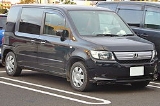
Honda mobilio spike
Encyclopedia
The Honda Mobilio Spike was a 1.5L compact-wagon that was designed with recreational activities in mind. The Mobilio Spike was released in Japan on September 19, 2002 and was Honda’s third model in the Small Max series. The Mobilio, according to Honda, attained the highest fuel rating in the 7-passenger vehicle class, at 17.2 km/L. All variants of Mobilio Spike meet domestic fuel efficiency requirements for 2010. It was discontinued in Summer 2008 following the release of the Honda Freed
.
The Mobilio Spike featured a spacious cargo area that was 6.09 ft (1.86 m) deep and 3.6 ft (1.1 m) tall and could be configured in 5 modes; utility mode, long mode, twin mode, refresh mode, and adjustment mode.
Along with the flexible cargo configurations, there are two sliding doors, one on each side. Interior tailgate storage hooks can hold about 11 lb (5 kg).
The 1.5L VTEC engine is designed for both power and fuel economy. The Japan Ministry of Transport recognized the Mobilio Spike as an “excellent low emissions” vehicle. Also featured in the Mobilio Spike is the Honda Multimatic S (CVT
). It is Honda's new generation of CVT with 7-speed mode that offers three driving modes: CVT; 7-speed automatic shift mode; and 7-speed manual shift mode. Four-Wheel Drive is also available.
The Mobilio Spike incorporates Honda's G-CON (G-force Control) technology, for enhanced crash safety. The vehicle body is designed to offer protection to occupants in a 55 km/h full-frontal collision, a 64 km/h front offset collision, 55 km/h side collision, and a 50 km/h rear collision.
Honda has implemented its own vehicle-to-vehicle collision testing program: 50% frontal offset collision with a 2-ton class vehicle while both vehicles traveling at 50 km/h, to help improve safety in real-world collisions.
In order to enhance recyclability, almost all interior injection-molded parts are made of olefin resin. Together with other measures, it results in an overall vehicle recyclability of over 90%.
Honda Freed
The Honda Freed is a Mini MPV produced by the Japanese automaker Honda since 2008. The vehicle is a replacement for the Honda Mobilio. The Freed is based on the Jazz/Fit platform. Three different versions of the Freed are available: a seven-seat version which features captain’s seats in the second...
.
The Mobilio Spike featured a spacious cargo area that was 6.09 ft (1.86 m) deep and 3.6 ft (1.1 m) tall and could be configured in 5 modes; utility mode, long mode, twin mode, refresh mode, and adjustment mode.
Along with the flexible cargo configurations, there are two sliding doors, one on each side. Interior tailgate storage hooks can hold about 11 lb (5 kg).
The 1.5L VTEC engine is designed for both power and fuel economy. The Japan Ministry of Transport recognized the Mobilio Spike as an “excellent low emissions” vehicle. Also featured in the Mobilio Spike is the Honda Multimatic S (CVT
Continuously variable transmission
A continuously variable transmission is a transmission that can change steplessly through an infinite number of effective gear ratios between maximum and minimum values. This contrasts with other mechanical transmissions that offer a fixed number of gear ratios...
). It is Honda's new generation of CVT with 7-speed mode that offers three driving modes: CVT; 7-speed automatic shift mode; and 7-speed manual shift mode. Four-Wheel Drive is also available.
The Mobilio Spike incorporates Honda's G-CON (G-force Control) technology, for enhanced crash safety. The vehicle body is designed to offer protection to occupants in a 55 km/h full-frontal collision, a 64 km/h front offset collision, 55 km/h side collision, and a 50 km/h rear collision.
Honda has implemented its own vehicle-to-vehicle collision testing program: 50% frontal offset collision with a 2-ton class vehicle while both vehicles traveling at 50 km/h, to help improve safety in real-world collisions.
In order to enhance recyclability, almost all interior injection-molded parts are made of olefin resin. Together with other measures, it results in an overall vehicle recyclability of over 90%.

